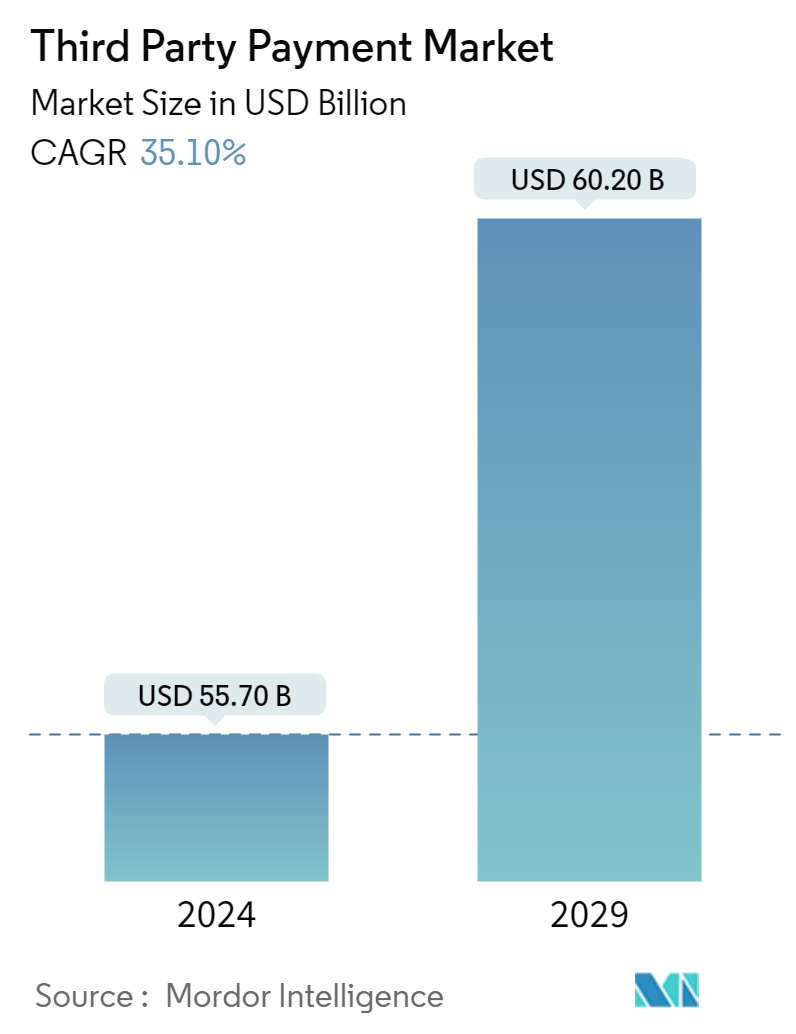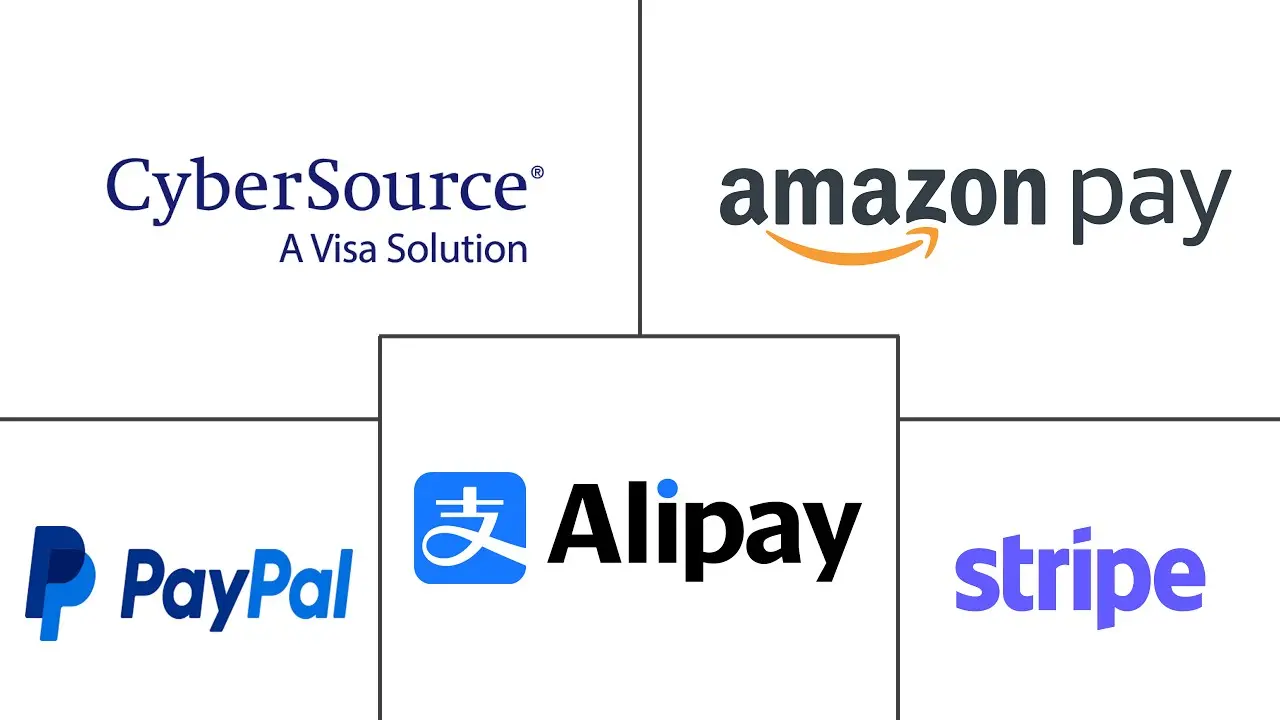Market Size of Third Party Payment Industry

| Study Period | 2019 - 2029 |
| Market Size (2024) | USD 55.70 Billion |
| Market Size (2029) | USD 60.20 Billion |
| CAGR (2024 - 2029) | 35.10 % |
| Fastest Growing Market | Asia Pacific |
| Largest Market | North America |
Major Players
*Disclaimer: Major Players sorted in no particular order |
Third Party Payment Market Analysis
The Third Party Payment Market size is estimated at USD 55.70 billion in 2024, and is expected to reach USD 60.20 billion by 2029, growing at a CAGR of 35.10% during the forecast period (2024-2029).
The third party payment market is expected to rise at a considerable rate between 2024 and 2029. More people and businesses are taking part in third-party transactions via online payment platforms due to the development of technology that has changed how users interact and conduct transactions in the digital age. For example, in a retail transaction, PayPal is an online payment portal that acts as a third party, where the seller and the buyer can perform the transaction, and the payment is made using the PayPal gateway.
- Enterprises across sectors have made a major effort to accept digital payments, particularly in small business-to-business transactions. Third-party involvement in transactions has been an essential factor owing to its convenience and relatively simple nature.
- The flow of payments has changed as more companies incorporate payments into their products. Third-party payments, where businesses move money for their customers, have become more prevalent than traditional accounts payable and receivable or first-party payments.
- Moreover, third-party payment processors often charge higher per-transaction fees compared to traditional merchant accounts, and customer identity is obfuscated. Security threats and technical integration factors might hamper the market's growth.
- Although the third party payment market is highly competitive, the market is expected to grow as the global recovery trend post-COVID is clear, and investors are optimistic as the market growth looks promising. Therefore, it is expected that there will be more investment in this field in the coming years.
Third Party Payment Industry Segmentation
Third-party payment involves digital platforms through which a buyer can pay for the purchase of a good or service from any seller. The third-party vendor accepts the payment on behalf of the seller, verifies that the funds are available, and subsequently debits the amount. The money is sent to the seller’s account using the same online portal. Once the deposit has been made in the account, the seller may withdraw the funds from the bank account.
The third party payment market is segmented by type (online, mobile, and point of sale), end user (BFSI, retail, e-commerce, and other end users), and geography (North America, Europe, Asia Pacific, South America, and Middle East and Africa). The market sizes and forecasts are provided in terms of value (USD) for all the above segments.
| By Type | |
| Online | |
| Mobile | |
| Point of Sale |
| By End User | |
| BFSI | |
| Retail | |
| E-Commerce | |
| Other End User |
| By Geography*** | |
| North America | |
| Europe | |
| Asia | |
| Australia and New Zealand | |
| Latin America | |
| Middle East and Africa |
Third Party Payment Market Size Summary
The third-party payment market is poised for significant growth, driven by technological advancements and the increasing adoption of digital payment platforms. As more individuals and businesses engage in online transactions, the market is experiencing a shift from traditional payment methods to third-party solutions like PayPal, which facilitate transactions between buyers and sellers. This transition is particularly evident in small business-to-business transactions, where the convenience and simplicity of third-party involvement have become essential. Despite the competitive landscape and challenges such as higher transaction fees and security concerns, the market's growth trajectory remains promising, supported by a global recovery trend post-COVID and optimistic investor sentiment.
Regions like Asia-Pacific and EMEA are expected to be key drivers of market expansion, with a notable reduction in cash usage at points of sale. The proliferation of mobile payment applications and devices, such as PayPal, Samsung Pay, and Apple Pay, is transforming consumer habits and lifestyles, further propelling the market. In Asia, government initiatives and the rapid adoption of digital payment systems are fostering a cashless economy, with e-commerce and point-of-sale proliferation playing significant roles. The market is highly competitive, with established players like PayPal Holdings Inc., Stripe Inc., and Alipay.com Co. Ltd., alongside emerging startups, all vying for market share. Recent developments, such as partnerships and new features, indicate ongoing innovation and expansion within the sector.
Third Party Payment Market Size - Table of Contents
-
1. MARKET INSIGHTS
-
1.1 Market Overview
-
1.2 Industry Value Chain Analysis
-
1.3 Industry Attractiveness - Porter's Five Forces Analysis
-
1.3.1 Threat of New Entrants
-
1.3.2 Bargaining Power of Buyers/Consumers
-
1.3.3 Bargaining Power of Suppliers
-
1.3.4 Threat of Substitute Products
-
1.3.5 Intensity of Competitive Rivalry
-
-
-
2. MARKET SEGMENTATION
-
2.1 By Type
-
2.1.1 Online
-
2.1.2 Mobile
-
2.1.3 Point of Sale
-
-
2.2 By End User
-
2.2.1 BFSI
-
2.2.2 Retail
-
2.2.3 E-Commerce
-
2.2.4 Other End User
-
-
2.3 By Geography***
-
2.3.1 North America
-
2.3.2 Europe
-
2.3.3 Asia
-
2.3.4 Australia and New Zealand
-
2.3.5 Latin America
-
2.3.6 Middle East and Africa
-
-
Third Party Payment Market Size FAQs
How big is the Third Party Payment Market?
The Third Party Payment Market size is expected to reach USD 55.70 billion in 2024 and grow at a CAGR of 35.10% to reach USD 60.20 billion by 2029.
What is the current Third Party Payment Market size?
In 2024, the Third Party Payment Market size is expected to reach USD 55.70 billion.

